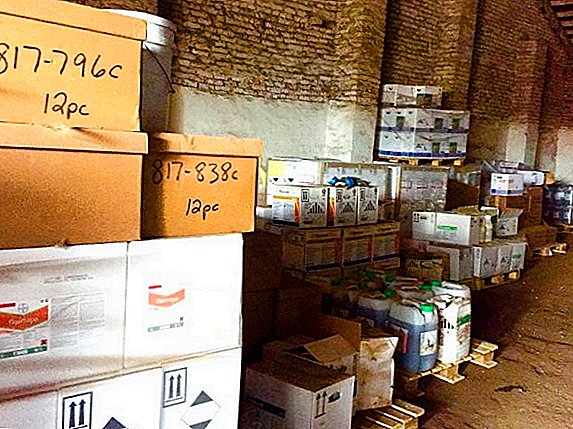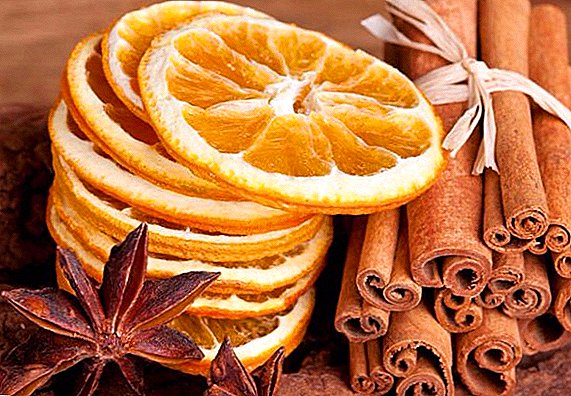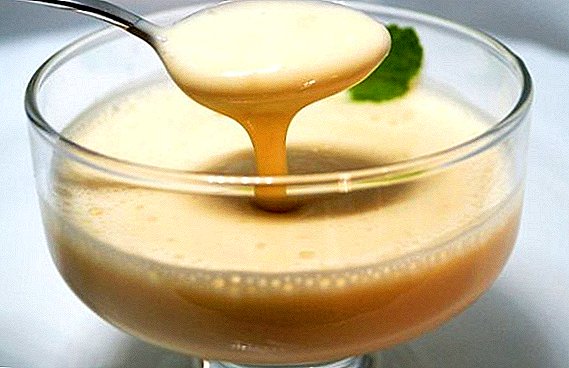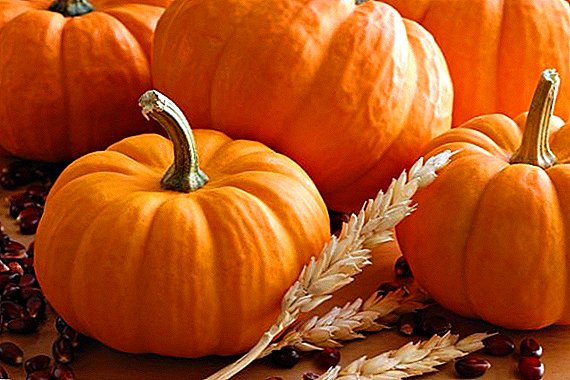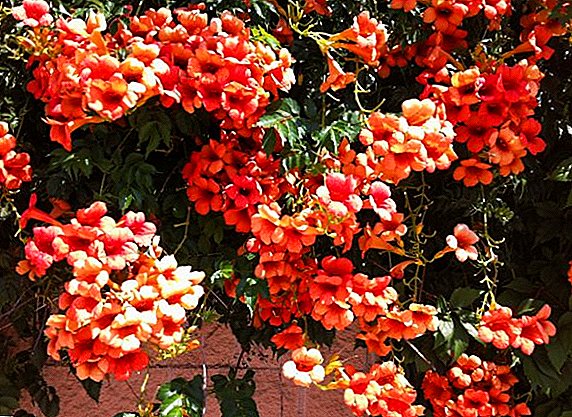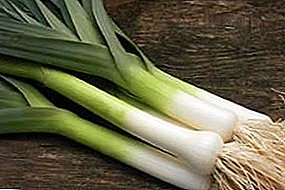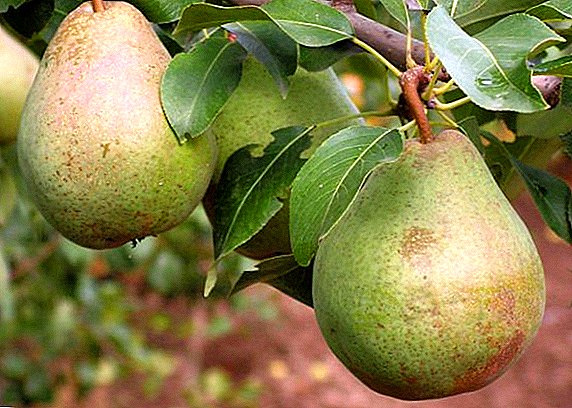 If you are in search of a pear variety that is not only capable of preserving the quality of its fruits, but even with time it is able to improve their organoleptic properties - this article, without a doubt, is intended for you. It will focus on the later Belarusian pear, the description of this variety, the intricacies of planting and caring for it.
If you are in search of a pear variety that is not only capable of preserving the quality of its fruits, but even with time it is able to improve their organoleptic properties - this article, without a doubt, is intended for you. It will focus on the later Belarusian pear, the description of this variety, the intricacies of planting and caring for it.
Breeding history
This type of tree was first obtained by sowing the seeds of free pollination varieties of French pear "Good Louise". For the first time, this method was decided by scientists of the Belarusian Research Institute of Horticulture, which is now called the Institute of Horticulture, National Academy of Sciences of Belarus.
Did you know? In the time of ancient Greece, the fruit of the pear was used as a means of motion sickness. Greek seafarers absorbed thin slices of these fruits until the symptoms of the disease subsided.
The authors of this variety are considered on a level with 3 breeders: G. K. Kovalenko, M. G. Myalik and N. I. Mikhnevich. Since 1989, this variety has been entered in the State Register of Varieties and Breeds of the BSSR, and since 2002 it has been included in the State Register of Breeding Achievements, which is allowed to apply in Russia.
Description and distinctive features of the variety
It is worth noting that the variety got its name for a reason. The first part of it, as is already clear, indicates the territorial affiliation of the first bred tree of this variety, the second means that the fruits of this tree ripen in autumn and winter.
Wood
This tree has a fairly average size. The height of an adult plant rarely exceeds 5 m, the crown volume varies from 3 to 4.5 m. The crown has a fairly voluminous structure, a spherical shape, the main branches form an angle of 90 ° with respect to the trunk. The shoots have an average thickness, a rounded section and covered with fibers, the color of which varies from light white to light brown.
Check out such varieties of pears as: "Otradnenskaya", "Kokinskaya", "Fairytale", "Nika", "Rogneda", "Elena", "Lada" and "Rossoshanskaya dessert".The kidneys are cone-shaped, small in size, bare. The branches are covered with a variety of lentils. The leaves are of medium size, the shape - from round to oval. The leaf edge is wavy, somewhat jagged, resembles a saw with fine teeth. Color - light green, smooth to the touch, fairly dense. The flowers are rather large in diameter, have ellipsoid petals and are white in color.
Fruits
The size of the fetus compared with most other representatives of this species - medium. The average weight is about 100-120 g. The fruits are elongated, the skin is rather dull in color, carries a lot of roughness. The entire surface is rippled with a light brown tint. Coloring depends on the degree of maturity and the time that the fetus lay in a torn form. As a rule, during the period when the harvest is done, the color of pears is greenish with patches of brownish-red hue, and in the period most suitable for consumption, they acquire a yellow color with a slight reddish tinge.
Did you know? Pear - a fairly close relative of the rose, because along with the last, as well as with hawthorn, apple trees and even more than 2000 thousand plants, belongs to the order Rosaceae.
The inside of the pears is white, has a pleasant, moderately pronounced pear smell with a hint of vanilla, very juicy, sweet and delicate in taste. The structure of the pulp is fine-grained, oily to the touch.
What to look for when buying seedlings
First of all, it should be remembered that in no case can one make a purchase on spontaneous markets, since the sellers for them are very poor or do not follow the species purity of their seedlings at all. In addition, in such markets, very often the roots of young trees are wrapped in plastic bags, which greatly damages them and has a very bad effect on their future survival. Even if you are lucky enough to get a viable seedling, the likelihood that this will be a wilderness will be very high. It is highly desirable that the seedling be grown and planted in the climatic zone, which would most closely correspond to the place where you intend to plant the young tree. This will facilitate rooting and contribute to the best growth and development of the future plant.
Important! Particular attention should be paid to the root system of the stock. It should have a powerful structure and a healthy appearance that will certainly contribute to the successful rooting and proper development of the seedling.
Pear seedlings of this variety are often grafted on seedlings of a different pear variety, which, however, must necessarily have greater resistance to droughts. It is not necessary to take pear seedlings that were grafted on cotoneaster, hawthorn, irgu and quince, because they do not have the proper level of severity of drought tolerance.
Choosing a place on the site
The best place for planting this type of pear will be a plot that is under the influence of sunlight for the longest possible time during the day, since the pear is a light-loving plant. It is also necessary to take into account the size of an adult tree, leaving for its development a plot of at least 4 × 4 m. The soil best suited for planting pears is black soil rich in various organic matter.
For planting in the middle lane are suitable varieties such as: "Marble", "Duchess" and "Favorite Yakovlev".The soil must have adequate air and water permeability. The root system of this type of pears is especially vulnerable to the occurrence of various fungal diseases, so the soil should not be satiated with excessive moisture. Sandy and clay soils are suitable for growing pears worst of all, because on such a land the plant is not able to fully develop its root system, which leads to inadequate development.
Preparatory work before landing
At first, the young tree will need well-loosened and fertilized with a large number of minerals soil. Therefore, it is necessary to lay a mixture in the pit intended for planting, which consists of 2 manure buckets, 2 sand buckets, 35 g of potassium-containing substances, and 20 g of superphosphate. Be sure to loosen the soil, which you intend to sprinkle a young plant, and also weed all the weeds in its habitat. It is worth taking care that all actively decomposing components and residues of other pear species were removed from the soil, since they may be infected with various parasites and diseases characteristic of this plant species.
Important! To improve the process of forming the root system, it is recommended to process the sapling with the help of a root growth stimulator, for example, Charkora.
Next is to prepare a sapling. To do this, they tear off all the leaves and remove the branches and parts of the roots that bear obvious traces of damage. After that, the seedling should be soaked in water, placing its roots in the liquid for at least 3 hours. Then you can proceed to the direct process of landing.
Step-by-step process of planting seedlings
Belarusian late-grade pear has the following planting algorithm:
- At first it is necessary to prepare a pit with a diameter of 1 m and a depth of about 80 cm. In the event that the roots of the plant are covered with an earthy clod, the pit is dug in accordance with its size.
- Next, the young plant is immersed in a pit in such a way, so that its roots are fully laid out in it and never bend. At the same time, the root neck should protrude 6-8 cm above the ground.
- A pit with a submerged seedling is filled with a fertile layer of soil, which is compacted as it is added.
- The young pear is poured with plenty of water (about 3-4 buckets).
- After moisture absorption, it is worthwhile to mulch the soil near the plant stem with the help of humus, fallen leaves or hay.

Seasonal care features
Pears are quite unpretentious in terms of tree care. The main pillars on which a successful harvest is based are: timely pruning, fertilization on time, and the prevention of various diseases and pests.
Soil care
During the first 2 years after planting, it is necessary to strictly monitor the state of the ground area around the trunk: weed in time in a timely manner and shallow soil loosening (5-7 cm). In order to combat weeds, you can apply various solutions of herbicides.
Important! It is extremely important that the active herbicide solutions do not fall on the cultivated plants, as this can cause them significant harm. Therefore, spraying with them is carried out only in calm weather.
After some time, some types of grass can be planted near the tree, for example, some kind of clover, red fescue or meadow bluegrass. These plants, after mowing, will serve as a very good source of mineral fertilizers for your pear. This variety of pears has a fairly high resistance to dry conditions, therefore, as a rule, does not require additional moisture. However, in conditions of excess heat, these trees recommend watering 2 times a day, at the rate of about 5-7 buckets of water for each adult tree.
 Regular mulching of the tree trunk circle is carried out only in the first years of active development of young pears, then it is applied only occasionally when too dry conditions occur, in order to prevent excessive and too rapid evaporation of moisture from the soil. Mulching is carried out using hay, humus, freshly cut grass or fallen leaves.
Regular mulching of the tree trunk circle is carried out only in the first years of active development of young pears, then it is applied only occasionally when too dry conditions occur, in order to prevent excessive and too rapid evaporation of moisture from the soil. Mulching is carried out using hay, humus, freshly cut grass or fallen leaves.
Top dressing
In the spring, it is recommended to carry out 2 root dressings: one during flowering and another immediately after. Both of these dressings should consist of mineral fertilizers. For the first, a solution of nitrate is made in the ratio of 1:50 and further watering is carried out at the rate of 30 g of nitrate per square meter of the pear growing range. The second root dressing can be a solution of urea, at the rate of 180-220 g of substance per bucket of water.
Mineral fertilizers are the main feeding of fruit trees and shrubs.For fertilizing a single tree, about 5 liters of this solution will suffice. In the summer, it is best to fertilize using the foliar method. It would be best if these supplements contain substances rich in phosphorus and potassium, for example, a nitroammofosku, ammofosku or a solution of magnesium sulphate. Processing is carried out according to the instructions provided on the package with the drug. In the fall, one dressing is required, preferably at the end of September, which would contain a large amount of organic matter.
 This may be infusions of weeds, fermented and diluted 1:10 bird droppings or liquid mullein. You can also add wood ash at the rate of 1 cup per 1 square. m of soil. Mandatory for plants are only dressing conducted in the spring and autumn periods. Summer foliar applications are carried out based on the occurrence of the need for such plants, which can manifest itself in a change in the appearance of the tree or the quality of the crop.
This may be infusions of weeds, fermented and diluted 1:10 bird droppings or liquid mullein. You can also add wood ash at the rate of 1 cup per 1 square. m of soil. Mandatory for plants are only dressing conducted in the spring and autumn periods. Summer foliar applications are carried out based on the occurrence of the need for such plants, which can manifest itself in a change in the appearance of the tree or the quality of the crop.
Preventive treatment
Preventive spraying to save the crop from pests and diseases should be done at intervals of 1-2 weeks. You can use for this purpose solutions of various fungicides and insecticides, each of which has individual subtleties of preparations and methods of processing, which can be further refined on the packaging.
Important! The last processing of trees should be carried out no later than a month before the expected date of harvest.
It is worth remembering that any processing of these substances should be carried out in rainy weather with no wind at all. The most popular and versatile treatment substances include Bordeaux liquid, 5% urea solution and 5% potassium permanganate solution.

Pruning
Young trees need pruning, which is designed to form in their future lush crown. For this purpose, the young seedling is left within the 5 most well-developed branches and the trunk is cut off by ¼. Adults are prone to thickening of the crown. The image of mature trees is carried out with the beginning of spring and before the first autumn frosts strike. It aims to remove all small young shoots and damaged, dying branches. Conducting pruning pears, it is worth remembering that the crown should have a uniformly expanding downwards structure. If the central branches of neighboring trees are in contact, they should be properly shortened.
Protection against cold and rodents
The “Belarusian Late” grade pear has quite good frost resistance, however, if the winters in your region are not snowy, there is a risk of freezing of the roots located in the surface soil layer. Therefore, in the winter, it is recommended to cover the soil around the trunk with sawdust or humus. The trunks of freshly transplanted trees can be wrapped in paper. In order to protect against various rodents, you can apply a cheap and reliable method - tying a tree trunk with conifers.
 You can also use reeds or cut raspberry shoots. There are, in addition, various chemical compounds that have been specifically designed to fight rodents and have in their composition creolin or other chemicals designed to scare animals. We hope that this text has helped you in finding answers to your questions about pears of the Belarusian Late variety. Scrupulous implementation of all these recommendations will guarantee you a bountiful harvest. Good luck to you and your garden!
You can also use reeds or cut raspberry shoots. There are, in addition, various chemical compounds that have been specifically designed to fight rodents and have in their composition creolin or other chemicals designed to scare animals. We hope that this text has helped you in finding answers to your questions about pears of the Belarusian Late variety. Scrupulous implementation of all these recommendations will guarantee you a bountiful harvest. Good luck to you and your garden!


